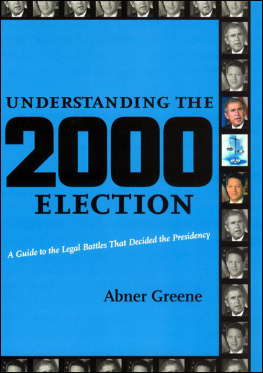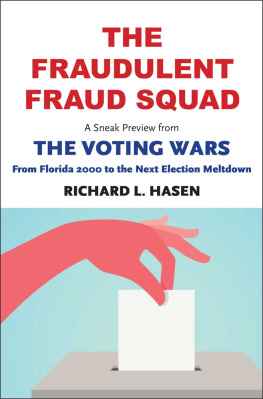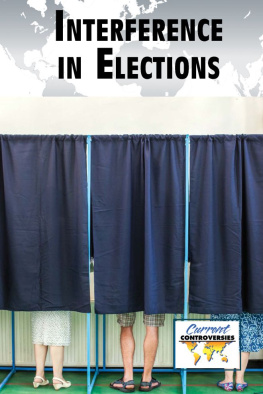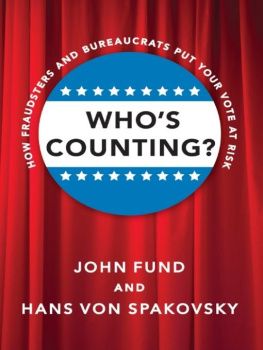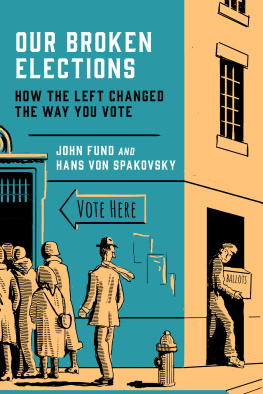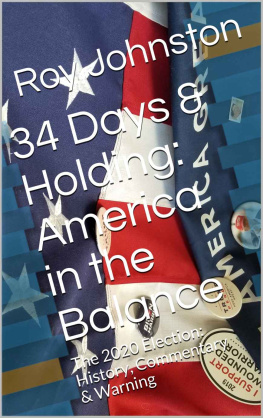Thank you for buying this ebook, published by NYU Press.
Sign up for our e-newsletters to receive information about forthcoming books, special discounts, and more!
Sign Up!
About NYU Press
A publisher of original scholarship since its founding in 1916, New York University Press Produces more than 100 new books each year, with a backlist of 3,000 titles in print. Working across the humanities and social sciences, NYU Press has award-winning lists in sociology, law, cultural and American studies, religion, American history, anthropology, politics, criminology, media and communication, literary studies, and psychology.
Understanding the 2000 Election
To the memory of my father, Phil Greene
NEW YORK UNIVERSITY PRESS
New York and London
2001 by Abner Greene
All rights reserved
Library of Congress Cataloging-in-Publication Data
Greene, Abner, 1960
Understanding the 2000 election : a guide to the legal battles that
decided the presidency / Abner Greene.
p. cm.
Includes index.
ISBN 0-8147-3148-1 (cloth : alk. paper)
1. Bush, George W. (George Walker), 1946 Trials, litigation, etc.
2. Gore, Albert, 1948 Trials, litigation, etc. 3. Contested elections
United States. 4. Contested electionsFlorida. 5. Presidents
United StatesElection2000. I. Title.
KF5074.2 .G74 2001
324.973'0929dc21 2001002835
New York University Press books are printed on acid-free paper, and their binding materials are chosen for strength and durability.
Manufactured in the United States of America
10 9 8 7 6 5 4 3 2 1
Introduction
Only once has the United States Supreme Court ended a presidential election. Only once has a presidential election come down to several hundred votes, in one state. Only once has a candidate won the presidency while losing the popular vote by more than 500,000 votes. The 2000 presidential election featured all of this, and more. It was instant history, and it will be studied by historians, lawyers, political scientists, biographers, media critics, and others for years to come.
This book offers an understandable, comprehensive guide to the legal battles that finally gave Governor George W. Bush the presidency five weeks after election night. Many legal issues captured the nations attention during those five late autumn weeks. For most of the time, the focus was on Vice President Al Gores insistence on manual recounts of punch-card ballots. Two cases involving manual recounts went through the Florida Supreme Court and up to the United States Supreme Court. Even amid the storm over manual counting, other issues demanded attention as well. In particular, courts resolved the Palm Beach County butterfly ballot case, challenging the legality of the ballot format, and two potentially devastating cases involving Republican Party alteration of absentee ballot request forms. In the background, lurking, was the Florida legislature, seemingly prepared to deliver Floridas electoral votes to Governor Jeb Bushs older brother. And off in the distance was the U.S. Congress, ready to play an uncertain role if the electoral matter remained unresolved into January 2001. This book covers all of these issues in detail not available in the newspapers or on television. At the same time, it breaks down their legal complexity, so lawyers and nonlawyers alike can follow along.
Everyone knew it would be a close election. All the national polls showed either Bush or Gore ahead by a smidgen going into election day. All the scenarios for electoral vote counting showed a similarly close race, with some pundits predicting that Bush might win the popular vote but lose the electoral vote and the presidency to Gore. (One of the many wonderful ironies of the election was that the pundits were 180 degrees wrongGore won the popular vote but lost the electoral vote and the presidency to Bush.) For Gore to win, he needed almost all the close states. Early on election night, it appeared he was winning them. Michigan fell his way, then Pennsylvania. And when the networks began calling Florida for Gore, it looked as if the White House was his.
But a funny thing happened on the way to a Gore White Housethe networks had erred in calling Florida. Some Gore supporters say that the networks did not err, that the exit polls showing Gore to be the victor in the Sunshine State were accurate, and that only bizarre irregularities such as the confusing Palm Beach County butterfly ballot resulted in a Bush victory. Whatever the case, the networks yanked Florida from the Gore column as midnight neared on election night and put it back into the undecided column. One A.M. passed, then 2 A.M., and the race was still too close to call. Gore picked up the key states of Wisconsin, Washington, and Iowa; Bush countered by prevailing in Arkansas and in Gores home state of Tennessee. Floridas twenty-five electoral votes, it appeared, would be critical for either candidate. If either could pick up Florida, he would be the next president.
Then, after 2 A.M., the networks called Florida, and the White House, for Bush. They pronounced him the forty-third president. Gore phoned Bush to tell him he would concede, and the celebration for the Texas governor was about to begin in Austin. But on the way to give his concession speech at War Memorial Plaza in downtown Nashville, Gore learned that Florida was much closer than the networks thought, close enough for him to demand a mandatory statewide recount. According to well-publicized reports, the following conversation occurred: Gore phoned Bush and retracted his concession. Bush was quite agitated by this, and Gore responded, You dont have to be snippy about it. When Bush said that his brother, Governor Jeb Bush of Florida, had assured him that Florida was a GOP win, Gore countered, Your younger brother is not the ultimate authority on this. America woke up the day after the election with the presidency hanging in the balance and with teams of Democratic and Republican lawyers flying into Florida to begin managing the recount process.
Over the ensuing five weeks, that counting continued, only to end with the instant landmark Supreme Court decision, Bush v. Gore. Bush had won Florida by 537 votes, and the presidency by 271 electoral votes to Gores 267.Constitution, as well as provide some historical background. That history includes the founding design of the Constitution and recounts the few times prior to 2000 that the winner of the popular vote did not prevail in the electoral vote. I also lay out some of the current debate over whether we should keep the electoral college. By the end of election night, the 2000 presidency was in doubt not because of the popular voteAl Gore had definitely prevailedbut because of the electoral vote. Neither candidate had clearly gained the 270 electoral votes needed.
The centerpiece of the legal battles was Gores attempt to recount thousands of ballots by hand. provides the background for what is to follow. The GOP waged a persistent campaign to discredit manual recounts. But Florida law, and the law in many other states, clearly provides for counting by hand. For example, as became known early on, Bush had signed into Texas law a provision for manual recounts. Caselaw from many states backs up what appears in the statutes: In close elections, human beings are entrusted to inspect ballots, and votes are counted on the basis of various indicia of a voters intent. But the law in most states, Florida included, does not provide clear rules on what ballot markings count as evidence of a voters intent. This lack of guidance ultimately became the key to the election, and to Gores demise. This chapter discusses the purpose of hand counts, surveys their use in Florida and elsewhere, examines the various types of chadsthose little pieces of the punch-card that do or dont fall out when you punch themand looks at how to figure out a voters intent depending on how the ballot-card is punched.

